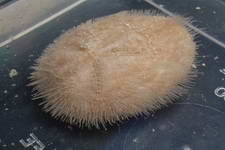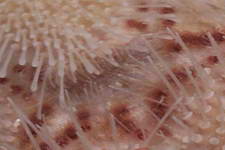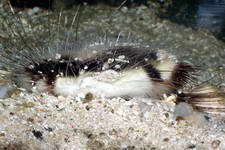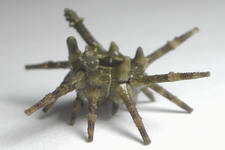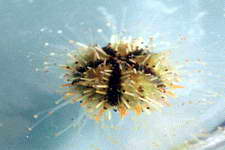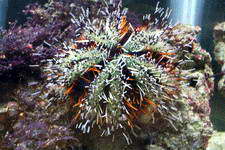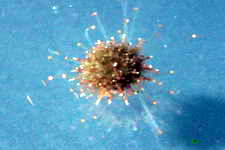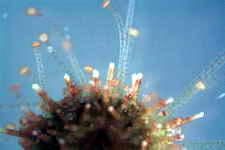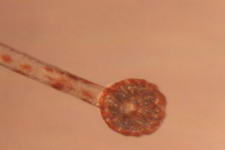

Blue form
Red form
Linckia multiflora -
While the below specimen is not a common coloration for this
species, it is however an example of the many differing patterns and
colors that the Linckia can be found in. Please see the above linked
article concerning the Linckia family.

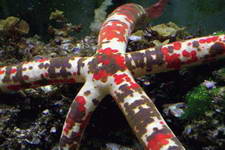
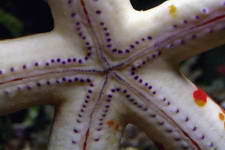 Protoreastor nodosus
Protoreastor nodosus
- Commonly called the chocolate chip starfish. As with the majority of
starfish, this family group is predatory and is not to be considered
reef safe, consuming a wide variety of prey including corals and
inverts, most notably clams. I would only keep this species as part of
a fish only
aquarium. They also come in a wide variety of colorations. In
the
last photo shown below, a starfish extending its stomach to consume
small shrimp that were fed to it. This is how such starfish
consume clams by forcing open the clam, however slightly, and injecting
their stomach into the clam's shell to consume the clam's flesh while
still inside its shell.

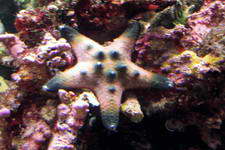
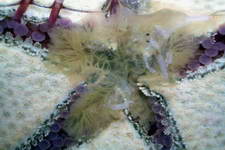 Fromia Imdica
Fromia Imdica
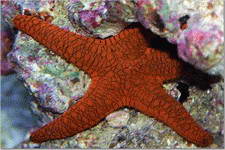 Mithrodia clavigera
Mithrodia clavigera - Nothing is known
about these animals but it would be safe to assume that it would not do
well within a typical aquarium as its food source is unknown.
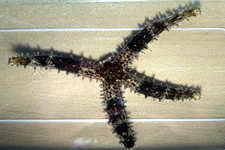
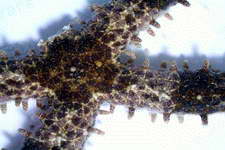
 Asterina Anomal
Asterina Anomal
- Typically a harmless herbivore, members of the Asterina family are
all but impossible to identify down to a species level. Since as with
most marine families, there are members whose diets vary greatly, which
can lead to confusion as to which species is reef safe or not.

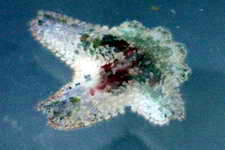
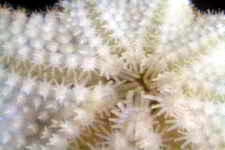
Unidentified Coral Predator -
Found consuming an
entire Lithophyllon coral colony within my system. While it seems that
this species is a member of the Asterina family, it is a different
species and not to be confused with the harmless Asterina species shown
above.
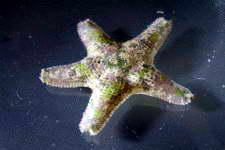
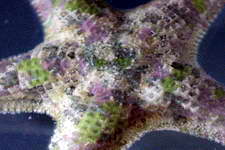

Below, yet another coral predator as it was found consuming a
Pocillopora spp.
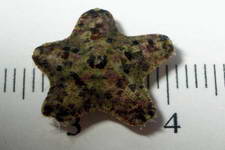
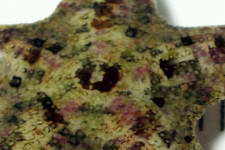
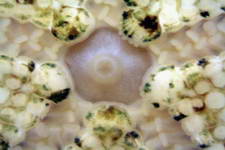 Archaster typicus
Archaster typicus
The so called
sand sifting starfish, please DO
NOT buy them. They will starve to death.

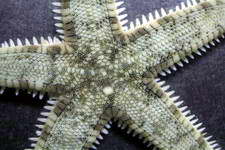

Echinaster luzonicus
( predator )
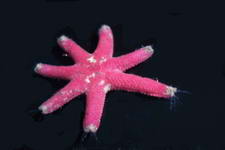
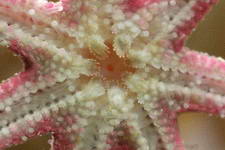
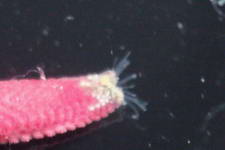 Acanthaster planci
Acanthaster planci
(crown of thorns starfish) Shown below is a 1cm juvenile
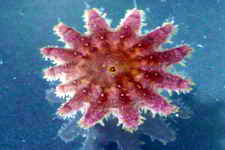
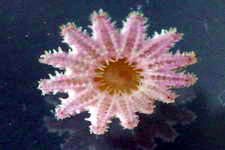
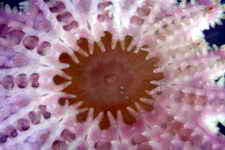
Unknown at this time, possibly a
Pentaster species.

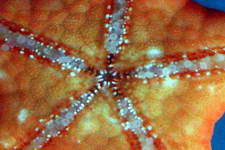
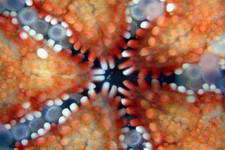
A Culcita species

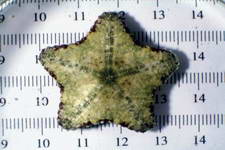
 Crinoids
Crinoids ( feather
stars ) and please, do not buy one.
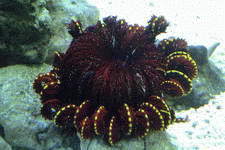
Basket Starfish - All basket
stars are
feeders on, rather large, zooplankton that they catch with their
divided arms. Most are nocturnal feeders, and they are often reclusive
during the day. Generally, they are difficult to keep, requiring
specific currents and relatively large amounts of food. The prognosis
for this animal, if it is a hitchhiker, is not good in most tanks.
Below specimen is a Gorgonocephalidae sp.
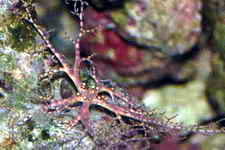
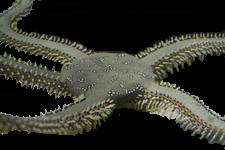
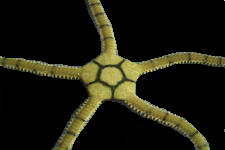
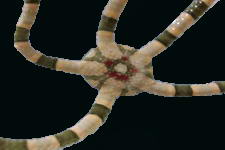
Ophiarachna incrassata
Ophioplocus imbricata
Ophiarachnella
gorgonia
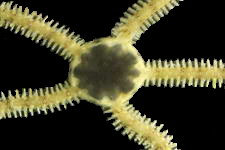
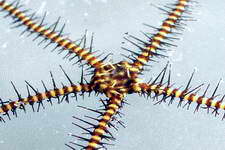
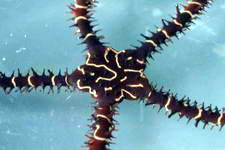
Yet
to be identified
A Juvenile Ophiomastix variabilis
Ophiomastix
variabilis
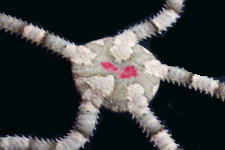
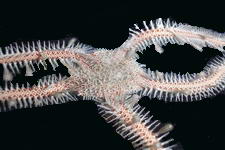
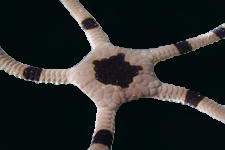
Ophiarthrum elegans
Ophiomastix
annulosa
Ophiolepis superba
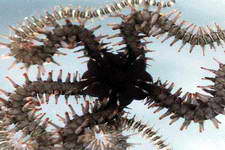
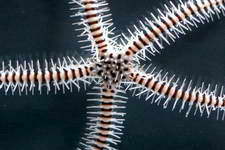
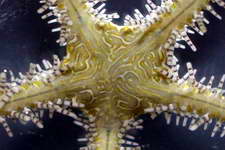
Ophiocoma erinaceus
Ophiomastix caryophyllata
Ophiarachnato sp.
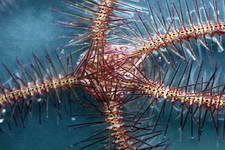

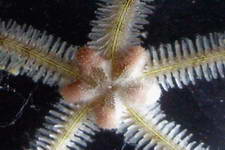
Acanthophiothrix sp.
Unidentified
Unidentified
SEA URCHINS
As
interesting as they are,
I do not allow them to remain in my reef aquarium simply because they
are just far to effective in their rock cleaning ability, if you value
your coralline algae and other small life on your rocks, then do not
add or allow an urchin to remain in your aquarium.
© 2016 ALL
RIGHTS RESERVED
All content and photographs are CopyRight
Protected
and may not be used,
copied or reproduced elsewhere
without permission of
the authors.
GO
BACK
Please
take a moment and
consider supporting any one of the projects listed within. Thank you.
Visitor Count since 24 Jan.08





























































